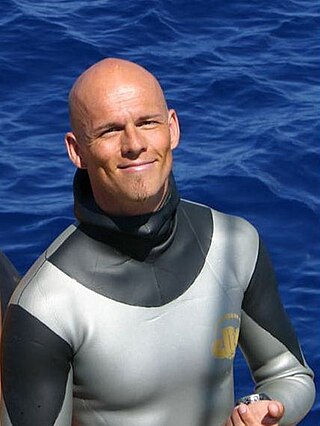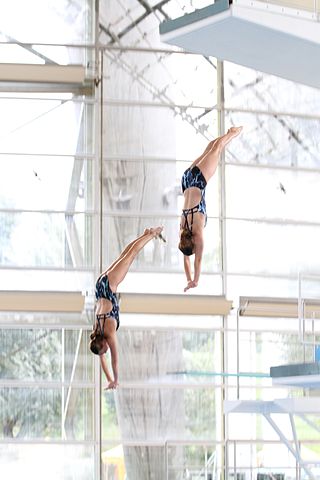
Trimix is a breathing gas consisting of oxygen, helium and nitrogen and is used in deep commercial diving, during the deep phase of dives carried out using technical diving techniques, and in advanced recreational diving.

Deep diving is underwater diving to a depth beyond the norm accepted by the associated community. In some cases this is a prescribed limit established by an authority, while in others it is associated with a level of certification or training, and it may vary depending on whether the diving is recreational, technical or commercial. Nitrogen narcosis becomes a hazard below 30 metres (98 ft) and hypoxic breathing gas is required below 60 metres (200 ft) to lessen the risk of oxygen toxicity.

Altitude diving is underwater diving using scuba or surface supplied diving equipment where the surface is 300 metres (980 ft) or more above sea level. Altitude is significant in diving because it affects the decompression requirement for a dive, so that the stop depths and decompression times used for dives at altitude are different from those used for the same dive profile at sea level. The U.S. Navy tables recommend that no alteration be made for dives at altitudes lower than 91 metres (299 ft) and for dives between 91 and 300 meters correction is required for dives deeper than 44 metres (144 ft) of sea water. Most recently manufactured decompression computers can automatically compensate for altitude.

A deep-submergence vehicle (DSV) is a deep-diving crewed submersible that is self-propelled. Several navies operate vehicles that can be accurately described as DSVs. DSVs are commonly divided into two types: research DSVs, which are used for exploration and surveying, and DSRVs, which are intended to be used for rescuing the crew of a sunken navy submarine, clandestine (espionage) missions, or both. DSRVs are equipped with docking chambers to allow personnel ingress and egress via a manhole.

An atmospheric diving suit (ADS) is a small one-person articulated submersible which resembles a suit of armour, with elaborate pressure joints to allow articulation while maintaining an internal pressure of one atmosphere. An ADS can enable diving at depths of up to 700 metres (2,300 ft) for many hours by eliminating the majority of significant physiological dangers associated with deep diving. The occupant of an ADS does not need to decompress, and there is no need for special gas mixtures, so there is little danger of decompression sickness or nitrogen narcosis when the ADS is functioning properly. An ADS can permit less skilled swimmers to complete deep dives, albeit at the expense of dexterity.
Boesmansgat, also known in English as "Bushman's Hole", is a deep submerged freshwater cave in the Northern Cape province of South Africa, which has been dived to a depth of 282.6 metres (927 ft).
The Woodville Karst Plain Project or WKPP, is a project and organization that maps the underwater cave systems underlying the Woodville Karst Plain. This plain is a 450-square-mile (1,200 km2) area that runs from Tallahassee, Florida, U.S. to the Gulf of Mexico and includes numerous first magnitude springs, including Wakulla Springs, and the Leon Sinks Cave System, the longest underwater cave in the United States. The project grew out of a cave diving research and exploration group established in 1985 and incorporated in 1990.
Royston Albert Fransen was a British high diver and stuntman. He was best known for his public displays of high and acrobatic diving, usually into shallow depth tanks and pools. These high dives were often performed with both diver and water surface being set ablaze with burning petrol. Fransen's professional high and fire diving career lasted over 40 years until an accident during an 1985 performance led to his death.
The Bathysphere was a unique spherical deep-sea submersible which was unpowered and lowered into the ocean on a cable, and was used to conduct a series of dives off the coast of Bermuda from 1930 to 1934. The Bathysphere was designed in 1928 and 1929 by the American engineer Otis Barton, to be used by the naturalist William Beebe for studying undersea wildlife. Beebe and Barton conducted dives in the Bathysphere together, marking the first time that a marine biologist observed deep-sea animals in their native environment. Their dives set several consecutive world records for the deepest dive ever performed by a human. The record set by the deepest of these, to a depth of 3,028 ft (923 m) on August 15, 1934, lasted until it was broken by Barton in 1949.

The Aquatic Center is a swimming, diving, and recreational facility in the city of Bakersfield, California, USA. It is located near Centennial Garden, newly renamed " Arena", in downtown Bakersfield. The Aquatic Center opened in June 2004. Combined with the Bakersfield Ice Sports Center, it has a large recreation pool and a heated competition pool, with lifeguards on duty during business hours. The facility hosts activities such as aquatic fitness, diving, lap swim, recreation swim, scuba, water polo, and much more. The facility hosts various local high school swim meets and is used by Bakersfield, California community members for recreational swimming.

Herbert Nitsch is an Austrian freediver who has held world records in all of the eight freediving disciplines recognised by AIDA International. He is the current freediving world record champion and "the deepest man on earth". This title was given to him when he set a world record in the "No Limit" discipline at the depth of 214 meters. To date, he has achieved 33 official World Records across all freediving disciplines, and one world record in the traditional Greek discipline of Skandalopetra 107 m (351 ft). He surpassed his own No Limit depth with a dive in June 2012 to 253.2 meters, suffering injury in the process.

High diving is the act of diving into water from relatively great heights. High diving can be performed as an adventure sport, as a performance stunt, or competitively during sporting events.
Pascal Bernabé is a French scuba diver who in 2005 laid claim to the world best for depth on a deep dive using self-contained breathing apparatus. Bernabé claimed to have reached a maximum depth of 330 metres (1,080 ft) using trimix on 5 June 2005 near Propriano, Corsica. This was actually deeper than the official deepest scuba dive recognized by Guinness World Records at the time. That mark, set by Nuno Gomes in Dahab, Egypt, was 318.25 metres (1,044.1 ft) of sea water. However, Bernabé's claimed deepest dive was not included in the Guinness Book of World Records due to insufficient evidence of such a dive ever being performed.
Professor Splash is the show name of Darren Taylor. Taylor is an American show diver from Denver, Colorado. He is well known for breaking high diving records using small pools. He holds the Guinness World Records for highest shallow water dive. Taylor has been on The History Channel's Stan Lee's Superhumans and explained the form of his famous dive. Taylor appeared on Discovery Channel's Time Warp and set a world record dive captured on slow motion cameras.
Ratio decompression is a technique for calculating decompression schedules for scuba divers engaged in deep diving without using dive tables, decompression software or a dive computer. It is generally taught as part of the "DIR" philosophy of diving promoted by organisations such Global Underwater Explorers (GUE) Innerspace Explorers (ISE) and Unified Team Diving (UTD) at the advanced technical diving level. It is designed for decompression diving executed deeper than standard recreational diving depth limits using trimix as a "bottom mix" breathing gas.

Project Nekton was the codename for a series of very shallow test dives and also deep-submergence operations in the Pacific Ocean near Guam that ended with the United States Navy-owned research bathyscaphe Trieste entering the Challenger Deep, the deepest surveyed point in the world's oceans.

The practice of decompression by divers comprises the planning and monitoring of the profile indicated by the algorithms or tables of the chosen decompression model, to allow asymptomatic and harmless release of excess inert gases dissolved in the tissues as a result of breathing at ambient pressures greater than surface atmospheric pressure, the equipment available and appropriate to the circumstances of the dive, and the procedures authorized for the equipment and profile to be used. There is a large range of options in all of these aspects.
Diamond Reef System, including each individual Hover Station and the new Multi-Portal System, are trademarked, skill evaluation and safety-based diving curriculums that utilize the world's first portable, collapsible underwater obstacle course to simulate fragile reef or dive wreck structure for diver buoyancy skill and underwater photography training. A form of scuba Gymkhana, the program was designed by Pete Wallingford in 1988 to educate scuba instructors and scuba divers on how to safely teach and promote situational awareness, proper body positioning and safe interaction with coral reefs, fragile marine ecosystems and shipwrecks. The program was adopted by the Environmental Protection Agency, the National Oceanic and Atmospheric Administration, dive store operators and dive resort/charter operators worldwide.

The history of underwater diving starts with freediving as a widespread means of hunting and gathering, both for food and other valuable resources such as pearls and coral, By classical Greek and Roman times commercial applications such as sponge diving and marine salvage were established, Military diving also has a long history, going back at least as far as the Peloponnesian War, with recreational and sporting applications being a recent development. Technological development in ambient pressure diving started with stone weights (skandalopetra) for fast descent. In the 16th and 17th centuries diving bells became functionally useful when a renewable supply of air could be provided to the diver at depth, and progressed to surface supplied diving helmets—in effect miniature diving bells covering the diver's head and supplied with compressed air by manually operated pumps—which were improved by attaching a waterproof suit to the helmet and in the early 19th century became the standard diving dress.

The metresea water (msw) is a metric unit of pressure used in underwater diving. It is defined as one tenth of a bar.













